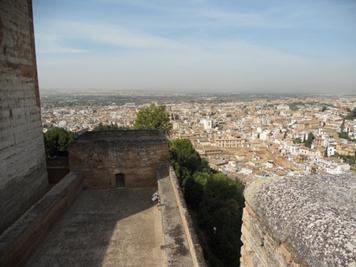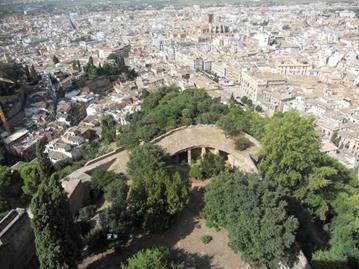Emeralds of the Alhambra is set in Granada, Spain, during the Castilian Civil War (1366-1369). Here I offer some historical background leading up to the beginning of the novel.
Following the power-vacuum created by the Christian-led collapse of the Berber Ahmohads who ruled al-Andalus, Muhammad ibn al-Ahmar ibn Nasr (Muhammad I), of the Arab Banu Nazari clan (the Nasrids), contrived in 1232 to set up a small kingdom centered on the lovely, mountain-girded city of Granada. At its largest, Muhammad’s kingdom is a mere one hundred mile wide swath of land at the extreme southeastern tip of Spain, stretching from the Mediterranean coast north of Almería, through Málaga, to Gibraltar. Inevitably, in 1245, reconquista (reconquest of Muslim Iberia by the Christians) knocks on the door, and Fernando III of Castile lays siege to Jaén, the well-fortified northern-most Muslim stronghold only forty miles north of Granada. To make peace, Muhammad reluctantly surrenders Jaén in 1246 and agrees to become a tribute-paying vassal to the king of Castile, ensuring at least a temporary halt to reconquista in the region. In hindsight, this was a profoundly shrewd move. The Nasrid Kingdom of Granada is born, and will prosper, wildly, through twenty Sultans and two-hundred forty-six more years, the last great seat of Muslim power in Iberia.

The famed “Vega de Granada” surrounds the city, at once a source of the kingdom’s pride and strength. The Vega is literally the floodplain of the river system emerging from the Sierra Nevada mountains. It becomes the fruit and vegetable and bread basket of Granada, flanked by miles upon miles of verdant grazing land, the envy of all of Europe in its culinary opulence. Stretching outward from the city walls far into the surrounding countryside, the mountain-rimmed Granadine Vega is breathtaking by medieval standards; flat, fertile, and lush. Irrigation is the lynchpin. Without it, Granada is practically a dustbowl. Sophisticated hydraulic systems lift and lower precious water at will from the convergent Darro, Genil and Beiro rivers. Irrigation dams within the fields channel water among the thirsty rows on a weekly rotation.
The splendor of the Vega is remarkable: Wheat, barley, rice, sugar cane, cotton, artichokes, eggplant, beans, endive, spinach, chard, radishes, leeks, carrots, beets, celery, peppers, onions, asparagus, figs, cherries, apples, pears, grapes, olives, oranges, lemons, limes, pomegranates, apricots, dates, almonds, pine nuts, hazel nuts, saffron, hot peppers, cumin, aniseed, mint, cinnamon, nutmeg, coriander, parsley, garlic, mustard. A Granadine feast. Typical European fare stands bland by contrast, centered on roasted meats, breads, grain gruels, and roots; spices and seasonings are available only for the rich. Cattle, horse, goat, sheep and chicken dung recharge the Vegan fields (pigs are forbidden in Islam). Arab mastery of irrigation, fertilizer, crop rotation, and fallowing precedes Europe by centuries.

Bickering among the rival Christian kingdoms, predictable exhaustion of coffers, and the threat from the emergence of the Muslim Marinids, yet another set of Berber clans who in 1244 conquer the Ahmohads to rule the Maghreb from Fez (in modern Morocco), stymies the Christian advance and reconquista comes to a grinding halt. Meanwhile, Granada thrives. Predictably, the Nasrids ally themselves with the Marinid Empire, and begin a long, slow, swaying dance as thinly sliced buffer between Christian Spain and the Muslim Maghreb, at the same time vassal of Castile and ally of the Marinids. Interesting times for the diplomatic corps!
Now to some specifics surrounding Emeralds of the Alhambra. Enter Muhammad V in 1354, age 16, eighth Nasrid Sultan of Granada. In 1358 the Christian kingdoms of Castile and Aragon (in northeast Spain) bicker and finally come to blows, and Granada, as vassal to Castile, lends its support (both financial and naval) to King Pedro of Castile (later nicknamed Pedro the Cruel), earning great favor at the Castilian court in Sevilla. Aragon bitterly resents the meddling by the Moors in Christian politics.
The plot thickens. Young Muhammad V falls victim to a coup led by his brother Ismail II on a sultry August night in 1359; sadly, orchestrated by Muhammad’s own mother, Maryam. Muhammad barely manages to escape with his life to Fez to live in exile with the Marinids. Ismail II is in turn assassinated in 1360 and replaced by Muhammad VI, their ambitious cousin. In 1362, Muhammad V, secretly encouraged and assisted by his unlikely ally, Pedro of Castile, crosses the Gibraltar Strait to reclaim his throne. Muhammad VI, in a painfully naïve move, races to Sevilla with his entourage and throws himself at Pedro’s feet, begging for help. Pedro welcomes him with open arms and a slap on the back, feasts lavishly with his Arab guests, then promptly has all thirty-seven arrested, stripped of their valuables, and two days later Pedro personally executes Muhammad VI. Pedro the Cruel. Muhammad V reclaims his throne and receives a welcoming gift from Pedro – his cousin’s head.
With Muhammad V successfully restored to power, a welcomed stability returns to the Granadine court and the kingdom flourishes under his benign rule. Muhammad V completes the glorious Alhambra, the lavish fortress-palace of the Granadine Royal Court. He even sends his masons to assist Pedro in remodeling his own palace in Sevilla in the Granadine style.
Alas, in 1366, after only four years of calm for Muhammad V and Granada, Enrique II of Trastámara launches the Castilian Civil War, and with the support of Aragon, France and the Pope, attempts to wrestle Castile away from his brother, King Pedro. As vassal of Pedro, Granada is once again reluctantly thrust center stage, ironically pinioned between the dueling Christian kingdoms of Castile and Aragon.
The stage is set, our story tiptoes close.